

Bloom Energy Server - Wikipedia, l'encyclopédie libre. The Bloom Energy Server (the Bloom Box) is a solid oxide fuel cell (SOFC) made by Bloom Energy, of Sunnyvale, California, that can use a wide variety of inputs (including liquid or gaseous hydrocarbons[1] produced from biological sources) to generate electricity on the site where it will be used.[2][3] It can withstand temperatures of up to 1,800 °F (980 °C), that would cause many other fuel cells to break down or require maintenance.[4] According to the company, a single cell (one 100 mm × 100 mm metal alloy plate between two ceramic layers) generates 25 watts.[5] Bloom stated that two hundred servers have been deployed in California for corporations including eBay, Google, Yahoo, and Wal-Mart.[6] Technology[edit] To save money, the Bloom Energy Server uses inexpensive metal alloy plates for electric conductance between the two ceramic fast ion conductor plates.
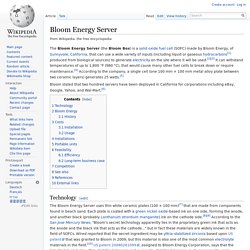
Bloom Energy. Un article de Wikipédia, l'encyclopédie libre.
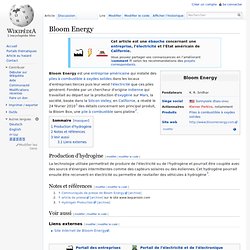
La Bloom Box et autres piles à combustible à hydrogène. There is a lot of hype right now about the “Bloom Box.”
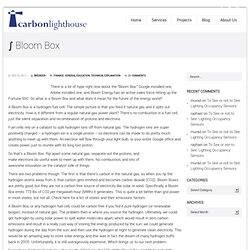
Google installed one, Adobe installed one, and Bloom Energy has an active sales force hitting up the Fortune 500. So what is a Bloom Box and what does it mean for the future of the energy world? A Bloom Box is a hydrogen fuel cell. The simple picture is that you feed it natural gas and it spits out electricity. 10 Questions About the Bloom Energy Server. Now that Bloom Energy has unveiled its innovative fuel cell technology to the world, it appears the much-hyped Silicon Valley startup's "Energy Server" shows a lot of promise, particularly for Fortune 500 companies that can afford the parking lot-sized power boxes priced up to $800,000 apiece.
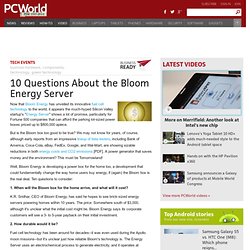
But is the Bloom box too good to be true? We may not know for years, of course, although early reports from an impressive lineup of beta testers, including Bank of America, Coca-Cola, eBay, FedEx, Google, and Wal-Mart, are showing sizable reductions in both energy costs and CO2 emissions [PDF]. A power generator that saves money and the environment? This must be Tomorrowland! Presque tout ce que vous voulez savoir sur la boîte de Bloom Energy [Vidéos] By now, you have probably heard of the Bloom Box, the green fuel cell device that promises to soon power our homes.
![Presque tout ce que vous voulez savoir sur la boîte de Bloom Energy [Vidéos]](http://cdn.pearltrees.com/s/pic/th/almost-everything-energy-7181902)
After appearing on CBS' 60 Minutes last week, its sand-based fuel cells generated a ton of buzz and media attention. Yesterday, Bloom Energy launched the Bloom Box in front of hundreds of investors, press, and well-known figures, including General Colin Powell (who sits on the board), California Governor Arnold Schwarzenegger and Google Co-founder Larry Page. Bloom Box - Les 50 meilleures inventions de 2010 - Heure. Inventors have tried to use hydrogen fuel cells as a cleaner way to create commercial electricity, but they've always been limited by the cost.
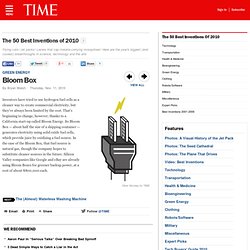
That's beginning to change, however, thanks to a California start-up called Bloom Energy. Its Bloom Box — about half the size of a shipping container — generates electricity using solid oxide fuel cells, which provide juice by oxidizing a fuel source. In the case of the Bloom Box, that fuel source is natural gas, though the company hopes to substitute cleaner sources in the future. Silicon Valley companies like Google and eBay are already using Bloom Boxes for greener backup power, at a cost of about $800,000 each.
Next The (Almost) Waterless Washing Machine. La Bloom Box, le dernier buzz de la Silicon Valley. Le gouverneur de Californie, Arnold Schwarzenegger, l'ancien ministre américain de la Défense, Colin Powell, l'investisseur John Doerr, associé du célèbre fonds de capital-risque Kleiner Perkins Caufield & Byers spécialisé dans les cleantechs...
K. R. Was the Hype Around Bloom Energy Two Years Ago Justified? About two years ago Bloom Energy revealed its top secret “Bloom Box” fuel cell system and immediately created an incredible buzz.
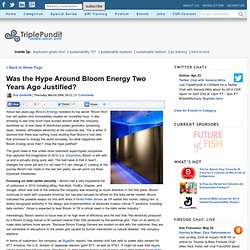
It was amazing to see how much hype buzzed around what the company described as “a new class of distributed power generator, producing clean, reliable, affordable electricity at the customer site.” For a while, it seemed that there was nothing more exciting than Bloom’s fuel cells that promised to change the world someday. So what happened with Bloom Energy since then? Was the hype justified?
The good news is that unlike other cleantech super-hyped companies that captured the imagination in 2010 (i.e. Focusing on data center security – Bloom had a very impressive list of customers in 2010 including eBay, Wal-Mart, FedEx, Staples, and Google, which was one of the reasons the company was receiving so much attention in the first place. Oxide Fuel Cells solides et la boîte Bloom. Navid Chowdhury December 7, 2011 Submitted as coursework for PH240, Stanford University, Fall 2011 Introductions Distributed Generation (DG) is the idea of generating power on site at the point of consumption (rather than at a central power grid) and it is becoming more and more essential at both commercial and household level.
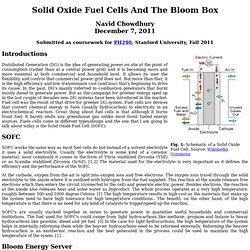
It allows its user the flexibility and control that commercial power grid does not. But more than that, it is the high efficiency and low transmission cost (and loss) that's beginning to drive its cause. SOFC works the same way as most fuel cells do but instead of a solvent electrolyte it uses a solid electrolyte. At the cathode, oxygen from the air is split into oxygen ions and free electrons. SOFC's are usually stacked together in series to generate power in quantities useful households and commercial institutions. Bloom Box: Qu'est-ce que c'est et comment ça marche? It’s being hailed as the Holy Grail of clean energy: a refrigerator-sized personal power plant that produces energy cheaply and cleanly and may one day replace the traditional power grid.
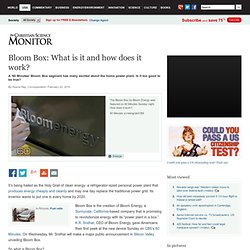
Its inventor wants to put one in every home by 2020. Skip to next paragraph Subscribe Today to the Monitor Click Here for your FREE 30 DAYS ofThe Christian Science MonitorWeekly Digital Edition. Bloom Box and Solar Power. It’s been several weeks now since Bloom Energy unveiled its “Bloom Box.” It’s a new and allegedly affordable solid oxide fuel cell that comes in a small package no bigger than a refrigerator. The point? To someday soon take every home off the grid. Or at least that’s the hope of company founder and CEO K.R.
Sridhar. eBay, Google, FedEx, Staples and other large companies (20 in total) have been secretly testing the boxes for months to apparent satisfaction. The Fuel. Bloom Energy Solid Oxide Fuel Cells. BloomEnergy cria eletricidade a partir de O2, 24.02.2010. Succès pour La Bloom Box de Bloom Energy. Lundi, 19 Septembre 2011 21:35. La Bloom Box: une centrale électrique pour la maison (vidéo) Exclusif: Le bénéfice de Bloom Energy - Le term sheet: les offres de Fortune Fiche blogTerm. FORTUNE -- For years, the knock on fuel cell maker Bloom Energy Corp. has been that its boxes cost more to make than they cost to buy. Not exactly the sort of dynamic that would help Bloom make it up on volume. But perhaps things are finally about to change, after 10 years and nearly $1 billion in venture capital funding.
Fortune recently obtained confidential documents sent by Bloom to its "significant investors," detailing third quarter earnings and the company's broader financial position. We also have managed to learn some broader context around the numbers, and have received what is believed to be the company's first on-the-record statement about its top-line projections for 2013 (all prior requests for information had gone unanswered). For the uninitiated, Bloom was founded by K.R. Despite the customer wins and technological advancements, however, Bloom has a reputation for burning money. Okay, not so good. Energy Server - Qu'est-ce que c'est? Built with our patented solid oxide fuel cell technology, Bloom's Energy Server® is a new class of distributed power generator, producing clean, reliable, affordable electricity at the customer site. Fuel cells are devices that convert fuel into electricity through a clean electro-chemical process rather than dirty combustion.
They are like batteries except that they always run. Bloom Box fuel cell officially launched. True to its word the formerly secretive Bloom Energy launched its Bloom “Box” (hereafter known as the Bloom Energy Server), today with an event at eBay’s California HQ attended by Governor Schwarzenegger and Bloom Energy board member Colin Powell. Although the launch didn’t see any great revelations to add to the 60 Minutes coverage of the versatile fuel cell earlier in the week, the company did provide a few more concrete specifications for the Bloom “Box”, as well as some of the corporate household names that are already customers. At the launch Bloom Energy founder, K.R. Sridhar, stressed some of the benefits of the technology. It is cheap - in comparison to other types of fuel cells anyway. Instead of expensive precious metals the Bloom Box consists of thousands of flat, solid ceramic squares made from a common sand-like "powder.
" Although the company has made a lot of noise about the technology being clean, there is a catch. Going for big business first seems to be a wise move. AT&T to Install More Bloom Boxes. AT&T has agreed to purchase an additional 9.6 megawatts of Bloom Energy Servers (shown above) to provide energy for its facilities and data centers (Image: Bloom Energy) Bloom Energy continues to gain traction for its fuel cell technology with major data center operators. AT&T said today that it will purchase an additional 9.6 megawatts of fuel cell capacity, which will make it Bloom Energy’s largest non-utility customer.
In July 2011, AT&T announced plans to deploy 7.5 megawatts of ”Bloom Boxes” at 11 AT&T sites in California, including data centers. Google using Bloom box to power data center - Data center facilities pro. » VIEW ALL POSTS Feb 25 2010 9:02PM GMT Posted by: Mark Fontecchio Tags: Thanks! We'll email youwhen relevant content isadded and updated. Following Follow Data Center. Bloom Box, la boîte magique qui veut remplacer les centrales électriques. De notre correspondant à Los Angeles Imaginez un petit cube de 10 cm de coté capable à lui seul de satisfaire les besoins en électricité de toute votre maison. Bloom Box : les promesses d’une pile à combustible à installer chez soi. Bloom Box, l'énigmatique pile à combustible, chez vous dans dix ans ? Elle a été choisie par eBay, Fedex et Google . Ces entreprises qui ont choisi la Bloom Box. Bloom Box … l’énergie du futur.
Car Carrier's Powerplant Like a Bloom Box On a Boat. A Swedish car carrier now sailing from Germany to the United States is the world’s first ship with auxiliary power provided by a fuel cell. While fuel cells can’t propel ships — yet — Wallenius Lines’ M/V Undine features a 20 kilowatt methanol-fueled Wärtsilä WFC20 solid oxide fuel cell auxiliary power unit. The unit provides power when the ship is in port, eliminating the need for batteries and generators to run onboard navigation equipment, radios and creature comforts. If the solid oxide fuel cell sounds familiar, perhaps that’s because its the power source behind the much-hyped Bloom Box. Like the Bloom Box, the Wärtsilä SOFC operates at temperatures exceeding 1,100 degrees Fahrenheit. Also like the Bloom Box, the unit on the Undine didn’t come cheap: the EU contributed about $1.25 million to the consortium of researchers and maritime magnates known as METHAPU that created the ship’s high-tech, low-emissions auxiliary power unit.
Photos: Wärtsilä.